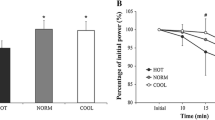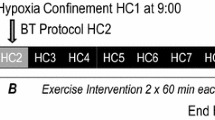Abstract
We have previously demonstrated a prolonged (65 min or longer) elevated plateau of esophageal temperature (T es ) (0.5–0.6°C above pre-exercise values) in humans following heavy dynamic exercise (70% maximal oxygen consumption, V˙O2max) at a thermoneutral temperature (T a) of 29°C. The elevated T es value was equal to the threshold T es at which active skin vasodilation was initiated during exercise (Thdil). A subsequent observation, i.e., that successive exercise/recovery cycles (performed at progressively increasing pre-exercise T es levels) produced parallel increases of Thdil and the post-exercise T es, further supports a physiological relationship between these two variables. However, since all of these tests have been conducted at the same T a (29°C) and exercise intensity (70% V˙O2max) it is possible that the relationship is limited to a narrow range of T a/exercise intensity conditions. Therefore, five male subjects completed 18 min of treadmill exercise followed by 20 min of recovery in the following T a/exercise intensity conditions: (1) cool with light exercise, T a = 20°C, 45% V˙O2max (CL); (2) temperature with heavy exercise, T a = 24°C, 75% O2 max (TH); (3) warm with heavy exercise, T a = 29°C, 75% V˙O2max (WH); and (4) hot with light exercise, T a = 40°C, 45% V˙O2max (HL). An abrupt decrease in the forearm-to-finger temperature gradient (T fa −T fi) was used to identify the Thdil during exercise. Mean pre-exercise T es values were 36.80, 36.60, 36.72, and 37.20°C for CL, TH, WH, and HL conditions respectively. T es increased during exercise, and end post-exercise fell to stable values of 37.13, 37.19, 37.29, and 37.55°C for CL, TH, WH, and HL trials respectively. Each plateau value was significantly higher than pre-exercise values (P < 0.05). Correspondingly, Thdil values (i.e., 37.20, 37.23, 37.37, and 37.48°C for CL, TH, WH, and HL) were comparable to the post-exercise T es values for each condition. The relationship between Thdil and post-exercise T es remained intact in all T a/exercise intensity conditions, providing further evidence that the relationship between these two variables is physiological and not coincidental.
Similar content being viewed by others
Author information
Authors and Affiliations
Additional information
Accepted: 10 December 1996
Rights and permissions
About this article
Cite this article
Kenny, G., Reardon, F., Giesbrecht, G. et al. The effect of ambient temperature and exercise intensity on post-exercise thermal homeostasis. Eur J Appl Physiol 76, 109–115 (1997). https://doi.org/10.1007/s004210050221
Issue Date:
DOI: https://doi.org/10.1007/s004210050221




